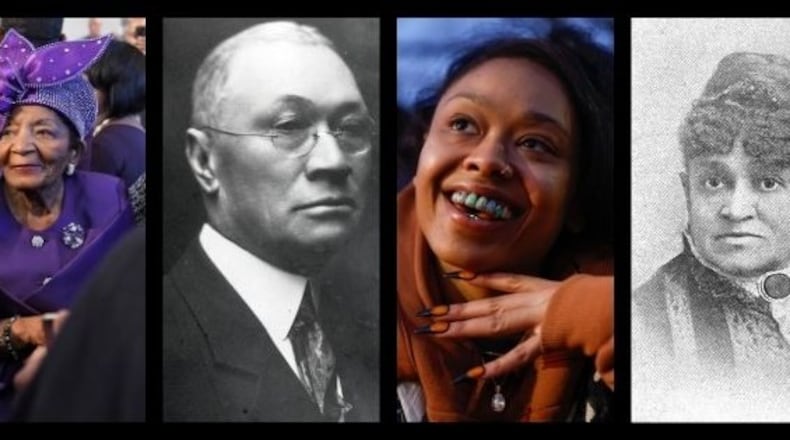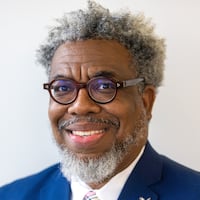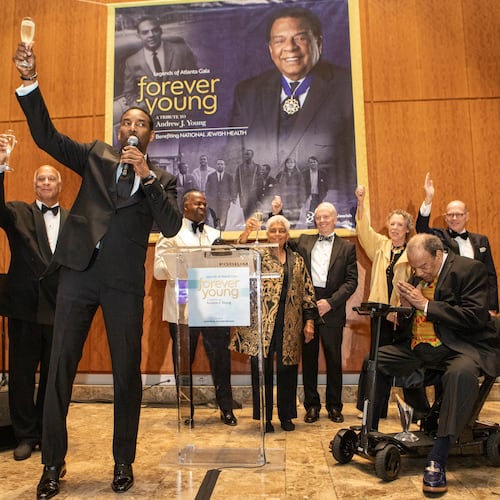Shirley Franklin is a tough critic. Especially of The Atlanta Journal-Constitution. That is why I approached her with caution last week after a lecture and book signing by the esteemed scholar David Levering Lewis.
I asked her if she had seen the big two-part series the paper had done for Black History Month and the legacy of Atlanta’s Black mayors, which featured her prominently.
Credit: Miguel Martinez-Jimenez
Credit: Miguel Martinez-Jimenez
“Yes, I saw it,” she said in that Philly accent she has never been able to lose despite all of her years in Atlanta. “And I liked it on (Instagram). Y’all have been doing a good job on Black History Month. And I really liked the story you did on the Black architects.”
Whew. We passed a crucial test.
But it was one that we had been preparing for 10 years. Today marks the end of our annual Black History Month Series, and to mark a decade of us doing this we presented “Atlanta Unveiled: How African Americans Shaped Atlanta.”
Along with luminaries like Franklin, we tried to weave a 28-day narrative that told unique stories about how Black brilliance and culture contributed to the city we all now know and love. That meant major A1 and Sunday pieces on the shaping of Atlanta, as well as a collection of daily new stories spread out over the month telling the important story of this city’s rise.
That included a wonderful and colorful look at the hats worn by women in the Rev. Martin Luther King Jr.‘s family and what church hats meant and mean to Black women.
Credit: arvin.temkar@ajc.com
Credit: arvin.temkar@ajc.com
Speaking of families, we also took a look at the another prominent one from Atlanta: The Dungeon Family, the pioneers who put Atlanta’s rap scene on the map. More specifically, we hung out with the “real” Dungeon Family to hear how the children of Sleepy Brown, Ray Murray and the late Rico Wade are holding down their legacies.
In addition, because we had nine years' worth of archives to dig through, we curated articles to showcase some of our best work, including: 10 historic moments that shaped Atlanta; some of our favorite images and sounds that tell Atlanta’s Black history; a nod to W.E.B. Du Bois with how Black scholarship, movements and influences shaped Atlanta and America; and our the best profiles in Black culture.
As usual, we got contributions from more than 20 reporters from all over the newsroom, as well as photographers, editors, artists, designers, and many others.
We even dragged an editor out of retirement to do a bulk of the heavy editing.
Shirley Franklin is pleased.
In case you missed any of the amazing stories that we told this year in the “Atlanta Unveiled: How African Americans Shaped Atlanta” series, here is a recap:
Sunday Living
On our Sunday Living covers, we really wanted to dig into what it meant to build and shape Atlanta with deeply reported and thoughtful long reads. We approached it three ways: Politically, financially and literally.
Credit: Atlanta Journal-Constitution
Credit: Atlanta Journal-Constitution
The story I mentioned to Mayor Franklin was an epic series that spanned over two weekends called “The rise and reign of Atlanta’s Black mayors.” City Hall reporter Riley Bunch sat down with five of the city’s six living mayors for intimate and revealing conversations about their tenures and legacy.
Credit: Miguel Martinez-Jimenez
Credit: Miguel Martinez-Jimenez
The project had never attempted a piece this massive, and with a stunning collection of new photography, it was a worthy and valuable piece of journalism.
“Thank you for the work that you do in keeping the legacy, not only of Maynard alive, but the mayors who followed him,” wrote Maynard Jackson’s widow, Valerie Jackson.
Credit: Miguel Martinez-Jimenez
Credit: Miguel Martinez-Jimenez
Of equal importance was Nedra Rhone’s exploration of how a little known collection of Black architects helped design and build Atlanta landmarks such as Hartsfield-Jackson Atlanta International Airport, Centennial Olympic Park, Zoo Atlanta, the Atlanta Botanical Garden, Ebenezer Baptist Church, Martin Luther King Jr. National Historic Park and birth home, Five Points and Midtown MARTA stations, the Buckhead Library, the Fulton County Courthouse, Underground Atlanta and the campuses of Spelman and Morehouse colleges.
In the final Sunday story, Mirtha Donastorg looked at how companies like Atlanta Life Insurance descended from the mutual aid and benevolence tradition among freed and enslaved African Americans in the 1800s to become a Black-owned insurance giant, obligated to taking care of their own in times of strife. And in the process, building Black wealth, security and dignity.
Credit: Jason Getz / Jason.Getz@ajc.com
Credit: Jason Getz / Jason.Getz@ajc.com
“Thanks again for a helpful article,” wrote the daughter of one of the company’s former certified public accountants. “Be sure and put a copy in the Atlanta History Center and the Auburn Avenue Research Library.”
Labor
If you have been following this series over the last decade, you know that we annually followed the themes of the Association for the Study of African American Life and History, the organization founded by Carter G. Woodson, which still administers Black History Month programming. This year’s theme was labor to mark the 100th anniversary of the founding of the Brotherhood of Sleeping Car Porters, which launched the Black organized labor movement.
Unlike past years, we didn’t devote our whole month to the theme, but every Monday — the beginning of the work week — we recognized ASALH by dedicating the day to labor.
We started with a look at the Sleeping Car Porters, the brothers who rode the rails for decades and helped build a Black middle class.
Credit: Library of Congress
Credit: Library of Congress
We rediscovered Elizabeth McDuffie, the maid from Atlanta who had the ear of President Franklin D. Roosevelt and championed rights for Black people.
Credit: Photo by AP/Shutterstock (5995534a)
Credit: Photo by AP/Shutterstock (5995534a)
And we dined with elite Black servers at some of Atlanta’s finest dining establishments to hear what they had to say about their opportunities to grow and prosper within the industry.
Credit: Henri Hollis
Credit: Henri Hollis
Family trees
Neither Gil Scott-Heron nor Sidney Poitier ever lived in Atlanta, but their roots run deep here.
Fernando Jones has lived in Atlanta all of his life, and his roots, we found, were much more complicated to find.
We started the month with retired reporter Shelia Poole, in her final story for the AJC, going to Fayetteville to rap with Rumal Rackley, the son of Scott-Heron. Holding his Grammy and flipping through old album covers and photographs, he shared the life lessons he got from his iconic father.
Credit: Daniel Varnado
Credit: Daniel Varnado
We ended the month with editor Mike Jordan taking readers through his own family tree and history and finding the great Poitier at the top of it.
Credit: Mike Jordan
Credit: Mike Jordan
Between the Scott-Herons and the Poitiers, we wrote about Fernando Jones, once a ward of the state of Georgia who grew up in the Carrie Steele-Pitts Home, the first and oldest Black-run orphanage in the country. We walked the grounds of the old orphanage with Jones as he searched for a tree he once fell out of. We were not sure if we found it, but we found peace.
Credit: Olivia Bowdoin
Credit: Olivia Bowdoin
Icons
We profiled two giants.
Alonzo Crim, who as Atlanta’s first Black schools superintendent, got the entire city involved in education.
Credit: Steve Deal / AJC file
Credit: Steve Deal / AJC file
And Herman Russell, who broke racial and economic barriers when he turned an Atlanta plastering startup into one of the nation’s most successful Black-owned real estate development and construction firms. He left a legacy that his family continues to expand.
The Griots
Stories can come in many forms, and we tried to explore many of them.
That meant reclaiming the complicated narrative of Br’er Rabbit, the trickster who originated in tales told by enslaved Georgians.
Credit: HYOSUB SHIN / AJC
Credit: HYOSUB SHIN / AJC
We visited another cultural landmark, the Neighborhood Arts Center, to explore the almost mythical place that rose in the 1970s as a space to celebrate Black creativity.
Credit: Jim Alexander
Credit: Jim Alexander
Expanding our reach throughout Georgia, we went to Savannah to visit the Black-owned Savannah Tribune, which is celebrating 150 years of delivering critical news to that coastal city’s African American readers.
Credit: Digital Library of Georgia Historic Newspapers Archive
Credit: Digital Library of Georgia Historic Newspapers Archive
And we listened to the blues thanks to Harry Pace’s Black Swan Records, the country’s first Black music label founded during the Harlem Renaissance.
Credit: WikiCommons
Credit: WikiCommons
The Pulitzers
We profiled two Pulitzer Prize winners this year.
David Levering Lewis, who won two Pulitzer Prizes for his biographies on W.E.B. Du Bois, was profiled by Gavin Godfrey for his latest book, “The Stained Glass Window: A Family History as the American Story, 1790-1958.”
Inspired by the stained glass windows of Atlanta’s historic First Congregational Church, the book took the scholar outside of his comfort zone by digging into the turning points, tragedies and triumphs befalling Black families.
Credit: Frank L. Stewart
Credit: Frank L. Stewart
We also profiled Winfred Rembert, whose deeply personal paintings documented the Jim Crow era. The Pulitzer Prize-winning memoirist grew up in South Georgia, where he survived a lynch mob attack and endured forced labor.
Credit: Courtesy of Erin I. Kelly
Credit: Courtesy of Erin I. Kelly
Trauma
Black history is often steeped in trauma. Winfred Rembert wrote about it and painted it.
Lena Mae Baker lived and died it.
In 1945, just six months after she killed a white man that she had accused of beating, kidnapping and raping her constantly, Baker became the first and only woman in Georgia to die in the electric chair.
Her story was largely forgotten.
Credit: COPY
Credit: COPY
We also brought light to Malcolm X’s 1961 trip to Atlanta.
On the 60th anniversary of his assassination, we retold a little-known story about Malcolm X’s visit to the city to meet with the Ku Klux Klan that shaped his thinking and charted his course to leave the Nation of Islam.
Credit: Eddie Adams
Credit: Eddie Adams
In the introduction of this series, I wrote that because of Black History Month, February is my favorite time of the year.
Looking back on all of the work we did this year with “Atlanta Unveiled: How African Americans Shaped Atlanta,” coupled with all of the work we have done over the past 10 years, and it is easy to see why.
Now it is on to 2026, which will be the 100th anniversary of Black History Month. Looks like we will have a lot of work to do.
And to look forward to …
ABOUT THIS SERIES
This year’s AJC Black History Month series, marking its 10th year, focused on the role African Americans played in building Atlanta and the overwhelming influence that has had on American culture. These daily offerings appear throughout February in the paper and on AJC.com and AJC.com/news/atlanta-black-history.
Become a member of UATL for more stories like this in our free newsletter and other membership benefits.
Follow UATL on Facebook, on X, TikTok and Instagram.
About the Author
Keep Reading
The Latest
Featured





















